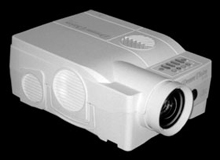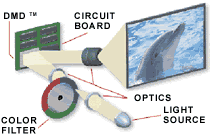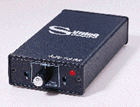The Dream Vision DLP500 Video Projector
| The Dream Vision DLP500 Video Projector |
| The American Dream Machine |
| Clement Perry |
| 5 June 2000 |
 Specifications
Specifications
Weight: 9.9 lbs. (4.5 kg)
Color Palette: 16.7 million colors (24-bit)
Resolution:
800 × 600 (SVGA)
1024 × 768 (with compression XGA)
Display: Single-Chip DMD™ (Digital Mirror Device™)
Aspect Ratio: 4:3, 16:9
Response Time: 16ms
Contrast Ratio:
230:1 (ANSI Checkerboard)
500:1 (ANSI Full on/off)
Computer Compatibility: SVGA, Modes 56 Hz – 85 Hz; VGA; PC, Macintosh,
Powerbook; and others
Video Compatibility: NTSC, PAL B/D/G/I/H/N/M, SECAM
Projection Lamp: 120-watt UHP
Lamp Life: Greater than 2,000 hours typical (5 years with typical use)
Brightness: Typical 600 ANSI Lumen
Projection Lens: Motorized zoom 1.2:1.7 with 17-degree keystone adjusted image
Focal Range: 5.74 ft. (1.75 m.) – 16.4 ft. (5 m)
Image Size (Optimal): 3.5 ft. to 14.4 ft. (diag.)
Zoom Factor: 1.5x
Uniformity: 85% image center-to-corner
Image configuration: Single “green button” set up with auto image positioning, auto tracking and auto synchronization
Audio System: Built-in 10-watt loudspeaker
Inputs (Full digital connectivity):
Computer (EVC plug)
S-video (MiniDIN/4pin)
Composite video (RCA)
Stereo Audio L/R (RCA)
RS232 connectivity
Outputs: Stereo Audio L/R (RCA)
Vertical Frequency: 48 Hz – 100 Hz
Horizontal Frequency: 15 KHz – 80 KHz
Power Input: 100-250V AC, 50 Hz-60Hz, full range
Operating Temperature: 50°F (10°C) to 104°F (40°C)
Dimensions: 13.2 in. (W) × 8.86 in. (D) × 5.122 in. (H) 335mm (W) × 225mm (D) × 130mm (H)
Option: Snap-in TV tuner
Included: All cables, adapters, remote control, cable organizer, dual carrying case
Distributors:
Audio Plus Services
P O Box 3047 Plattsburgh NY 12901
Tel: 800-663-9352
FAX: 450-585-5862
Sweet Dreams Are Made Of This
“The DL500 comes with an adorable (though uncommon looking) six button hand-held remote that more resembles a laser gun. (Scotty, set all phasers to stun!) My 13-year-old son, Martin, can’t keep his eyes off of it. Martin, no dummy, he, knows that hell has no fury like a dad who cannot lay hands on his laser remote!”
The audio and home theatre industries are moving along the digital freeway at a breakneck pace. Innovations such as DVD, HDTV, 64-bit gaming systems, digital cameras, digital satellite (DSS) and, of course Stereo Times, free of charge on the internet, are pure digital mediums with more on the horizon. Moreover, the images we view on screens will be created, captured, edited, or delivered digitally with jaw-dropping results. I had the opportunity to see one of its brightest new stars at HiFi ’99, in the Dream Vision (D)igital (L)ight (P)rocessing Model 500 projector. (For my report on Stereophile’s Hometheater and HiFi ’99 Show, held in Chicago’s Windy City which, overall, I found lackluster, go to http://stereotimes.com/chi_0599_two.htm.)
Seemed as if all the two-channel exhibitors are trying to turn two-channel audio into five-channel home theater. I doubt if that’s going to happen for some time (though Sony’s exhibit at the recent CES was something of a multi-channel eye-opener). Disappointed as I was, the show for me was saved by two very new products: Sony’s SCD-1 SACD player and Dream Vision DLP 500 Projector. I have listened and watched over the past year and am still enthralled by these products. I’ve written my impressions on the Sony. Now, nearly a year later, I want to express my joy at having lived with the Dream Vision DLP 500
I Have a Dream … Vision
The French manufacturer Dream Vision, designer of the DL500 projector (distributed in the United States through Audio Plus Services), isn’t exactly a big name in front-projection business. Similarly, Digital Light Processing (DLP), a likely successor of Liquid Crystal Display (LCD), isn’t the most familiar of technologies. Developed by Texas Instruments and based on Digital Light Processing (DLP) technology, the DL500 is about the size and weight of any standard one-chip LCD projector, about 10 lbs., but has greater light output, rated at 600 ANSI Lumens, with a less perceptibly pixilated picture than any LCD I’ve seen in its price class.
 One-chip DLP systems offer high brightness in a lightweight projector, which makes them ideal for displaying images in home theaters rather than movie theatres. In addition to brightness, there’s another benefit to DLP’s holds over LCD’s: DLP chips are based on silicon semiconductors rather than glass. This constitutes lower manufacturing costs, thus dramatically lower prices for DLP projectors.
One-chip DLP systems offer high brightness in a lightweight projector, which makes them ideal for displaying images in home theaters rather than movie theatres. In addition to brightness, there’s another benefit to DLP’s holds over LCD’s: DLP chips are based on silicon semiconductors rather than glass. This constitutes lower manufacturing costs, thus dramatically lower prices for DLP projectors.
The DLP500’s three inputs include composite (RCA), S-Video (MiniDIN/4pin), and RGB (15-pin RS232 male– female) connector, which make it compatible with most home theatre applications. I can’t claim that the DL500 is a feature-laden product since component video inputs, a major plus for DVD, are painfully absent. Its RS232 connectivity, however, is where it really shines by offering an upgrade path to picture-enhancement products like line doublers, quadruplers and the amazingly affordable DVDO I-Scan Plus.
The DL500 displays both 4:3, and (true) 16:9 aspect-ratios for wide screen playback. In addition, the DL500’s computer is compatible with most Powerbooks, PC’s, and Mac’s. A projection lamp rated at a modest 120-watt UHP boasts greater than 2,000 hours (5 years with typical use) lamp life. Read: a dog’s age of trouble-free maintenance. In addition, an optional Snap-in TV tuner is available upon request. Included as standard are all necessary cabling, adapters, and dual carrying case.
The DL500 comes with an adorable (though uncommon looking) six button hand-held remote that more resembles a laser gun. (Scotty, set all phasers to stun!) My 13-year-old son, Martin, can’t keep his eyes off of it. Martin, no dummy, he, knows that hell has no fury like a dad who cannot lay hands on his laser remote! The DL500 works much as a computer mouse steers a pointer. Clicking the menu opens the DL500’s on-screen horizontal listings: Standby, Auto Setup, Source, Setup, Adjustments, and Mouse. One chooses any of these merely by aiming the pointer over a directory and clicking the remote’s trigger. Once in a directory, for example, choosing Setup allowed me to adjust features like input, picture control, zoom, and aspect ratio, to name but a few.
Setup
From shipping carton to setup, screen installation (100 inch Dalite with 1.2 gain) to playback took all of forty minutes. The DL500 is a breeze to set up and operate, even for first-timers. Its clear, concise, and well-written manual insures a proper set-up every time, in case you ever need to retrace your steps.
My reference television for the past two years has been Toshiba’s TW40F80 16 by 9 Widescreen which, by the way, was calibrated by an ISF (Joe Kane’s Image Science Foundation) certified technician. I was blown away when I first noticed its picture at HiFi ’97, held in San Francisco. The DL500’s space requirements at 9″ by 13″ are relatively small while its feet are adjustable for centering its picture on a variety of screens. The usual component video hookup coming off the Sony DSP-7000 wasn’t going to work with the DLP500, forcing me to place a call to Harmonic Technologies’ Jim Wang. He obliged my request by suggesting that I try his newest reference product, the Cyber Link Silver (10 meters) S-Video and RCA cables. After their arrival, I sent them through a typical burn in (setting the Sony on repeat), for about one week.
I flipped the Dream Vision’s rear-mounted power switch, set its color temperature settings to True Color, and its aspect ratio to wide screen, hit the lights, and plopped into my easy chair, remote in hand, to see whether the Dream Vision DL500 could duplicate the incredible picture I witnessed back in the Windy City.
I was not disappointed.
The first movie I popped into the Sony DVD player is the incredibly well DVD-transferred sci-fi sensation, The Fifth Element. In one particular daylight scene where Milla Jovovich, playing the beautiful alien creature Leeloo, flees her captives by going out on the ledge of a huge skyscraper with police vehicles in hot pursuit, the picture was as impressive as I’ve seen from a two-piece unit irrespective of price. It didn’t possess the same brightness or sharpness level as my Toshiba, but what it did have it had in spades — SIZE not in the least disproportionate to its picture quality, which is what I always have found to be a disappointment in all the relatively inexpensive large screen projectors. The same scene demonstrates what I believe to be one of the DL500’s best qualities: the color of Leeloo’s hair is a yellowish orange and it was rendered just right, not too overdone or bland, comparing favorably to the smaller Toshiba and Sony in this regard. This speaks volumes about the quality of an 80-inch screen with a 16 by 9 aspect ratio. Pass the popcorn and stifle the chatter!
The size and scale of the picture the DL500 produces is mammoth, three dimensional and colorful without any noticeable artifacts from my 11-foot-distant sitting position (which I’m sure many would consider too close). My 100-inch Dalite screen captures a high level of brightness without obscuring color or causing hot spotting with a picture quality I thought restricted to small screens or big-money systems.
At the suggestion of Audio Plus Services’ East Coast rep Greg Rizzo, I installed the DVDO iScan Plus Line Doubler. This cute little critter costs only $699 and takes the picture quality of the DL500 to even greater heights. This 5.57″ by 1.5″ by 8.5″ black box, one pound in weight (!), has already set the industry on its ear. Its performance compares well to the that of the competitors, some of which cost twenty times as much! I thought the image and picture of the DL500 excellent without the iScan, but you know me, I love nothing more than tweaking. And tweak the DL500 is exactly what I did.
Tweakaholics Anonymous
Lucky for me, I use the Sony DVP S-7000, which apart from its many top of line features, also sports its own picture controls. That said, I did require a long length, about 40 feet, of S-Video cable to snake through the Sony to the DL500. The amount of cable necessary created a whole new set of problems. For example, whenever you use more than 10 feet of cable, even the finest grade cabling, you lose some resolution, brightness, and detail, this obviously affects the quality of the overall picture.
When watching cable television or playing straight through the VCR, I’m left with only the four settings available through the DL500’s menu. That isn’t the usual color, tint, and brightness controls I’m accustomed to on the Toshiba, or even the Sony DVD player for that matter. So what’s a tweakaholic to do? I found the answer in the Tributaries Model SA 201 S-Video Compensator.
 Here’s a unit that allows one to adjust for color (chroma), brightness (luminance), and contrast via a S-video electronic compensator. When using troubling long runs (anything over 10 feet up to lengths of 1000 feet!) of video cable, the SA201 is a must getz. The SA201’s dimensions are 2 ¾” W by 5 7/8″ D by 1 ¼” H, and weighs about 9 oz. It retails for $300.
Here’s a unit that allows one to adjust for color (chroma), brightness (luminance), and contrast via a S-video electronic compensator. When using troubling long runs (anything over 10 feet up to lengths of 1000 feet!) of video cable, the SA201 is a must getz. The SA201’s dimensions are 2 ¾” W by 5 7/8″ D by 1 ¼” H, and weighs about 9 oz. It retails for $300.
 The iScan Plus is a high performance, low cost line doubler introduced by a new startup company, DVDO, Inc. The iScan Plus converts the existing NTSC television and video signal 480 lines interlaced format to a DTV, Digital Television format known as 480 progressive. The diminutive iScan automatically detects the signal (whether S-video or composite) from its three inputs. No power switch. You simply plug it in from its detachable external power supply. I hooked my unit up between the Sony and the projector. My DL500 accepts RGB inputs only, so I flipped the little variable switch (progressive scan is the other) on its rear at this setting.
The iScan Plus is a high performance, low cost line doubler introduced by a new startup company, DVDO, Inc. The iScan Plus converts the existing NTSC television and video signal 480 lines interlaced format to a DTV, Digital Television format known as 480 progressive. The diminutive iScan automatically detects the signal (whether S-video or composite) from its three inputs. No power switch. You simply plug it in from its detachable external power supply. I hooked my unit up between the Sony and the projector. My DL500 accepts RGB inputs only, so I flipped the little variable switch (progressive scan is the other) on its rear at this setting.
Question: do line doublers double the number of lines in a video image? No! What a line doubler does is convert an interlaced scan into a progressive scan.
To transfer film to video isn’t as simple as most of us think. Here’s why: Film is shot at 24 frames per second, while video or current NTSC runs at around 30 fps. Video frames consists of two interlaced fields (odd and even) for a total of 60 fields per second. Getting these numbers to correctly correspond during film-to-video (telecine) transfer requires that an extra field be added to every other frame. This is known around the industry as 3-2 pulldown.
Interlaced scanning works fine as long as the screen is relatively small (and television screens are becoming increasingly larger). As the image size gets larger, so do the scan lines. Eventually, the spaces between the alternate sets of scan lines become obtrusive, producing a distracting venetian-blind effect. “Line doublers” get around this by illuminating all 525 lines in a progressive sequence at a rate twice as fast as an interlaced scan.
The iScan reassembles the interlaced fields into progressively scanned frames incredibly well, as well as inexpensively.
Master story teller Tim Burton’s Sleepy Hollow is a marvel. Bold, exciting and full of incredible imagery. I found myself totally captivated by the style of this motion picture. Johnny Depp is quite an actor playing Ichabod Crane, an eccentric investigator determined to stop the murderous Headless Horseman. I found the transfer to be solid in color, saturation, and detail. The vivid quality of this movie through the iScan really impressed as I found myself totally involved into the movie (along with the rest of the family).
With the iScan in the loop between the Sony and DL500, the picture is indeed sharper, with greater color saturation, detail, and contrast. In addition, the overall quality is more film-like — by far the best quality I’ve seen from a $699 line doubler. What we have here is a product that’s quite reminiscent of the now deceased Audio Alchemy products that bought first rate products to audiophiles on a budget.
I don’t have to go on trumpeting my obvious enthusiasm about the Dream Vision DL500, do I? It’s truly a state of the art product in its price range and competes with virtually all the others when equipped with a good line doubler such as DVDO’s iScan Plus. In terms of price/performance, the DL500 is without question a breakthrough product.
I am not unmindful of products capable of greater resolution than the DL500. But at what cost?
His Excellency Diminishing Returns is alive and well in the video industry too. Having lived with this product for the past year, I see the DL500 as the way to go. Given its ease of use and setup (not forgetting the Star-Trek remote), its 16 by 9 wide screen setting, and the upgrading option to an external video enhancer (such as the incredible iScan), what you have, dear reader, is a classic no-brainer.
![]()
Don’t forget to bookmark us! (CTRL-D)
Stereo Times Masthead
Publisher/Founder
Clement Perry
Editor
Dave Thomas
Senior Editors
Frank Alles, Mike Girardi, Russell Lichter, Terry London, Moreno Mitchell, Paul Szabady, Bill Wells, Mike Wright, and Stephen Yan,
Current Contributors
David Abramson, Tim Barrall, Dave Allison, Ron Cook, Lewis Dardick, John Hoffman, Dan Secula, Don Shaulis, Greg Simmons, Eric Teh, Greg Voth, Richard Willie, Ed Van Winkle, Rob Dockery, Richard Doran, and Daveed Turek
Site Management Clement Perry
Ad Designer: Martin Perry





Be the first to comment on: The Dream Vision DLP500 Video Projector